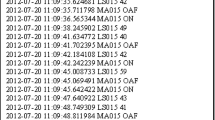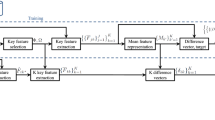Abstract
It is a common knowledge that the daily activities of senior people tell a lot about their health condition. Thus, we believe that analysing their activities at home will improve the health care. Toward this goal, we propose a senior home activity summary system. There are two challenging problems in such a real world application. First, the amount of data for different activity categories is extremely unbalanced, which severely degrades the classifying performance. Second, senior’s activities are usually accompanied by nurse’s walking. It is impractical to predefine and label all the possible activities of all the potential visitors. Consequently, we propose a technique called subspace Naive-Bayesian Mutual Information Maximization (sNBMIM). It divides the feature space into a number of subspaces and allows the kernel and normalization parameters to vary between different subspaces. Moreover, we propose a novel feature filtering technique to reduce or eliminate the effects of the interest points that belong to other people. To evaluate the proposed activity summary system, we have collected a Senior home Activity Recognition dataset (UESTC-SAR), and performed activity recognition for eight categories. The experimental results show that the proposed system provides quite accurate activity summaries for a real world application scenario.





Similar content being viewed by others
References
Amini S, Narasimhan P (2009) TwitterJacket: an automated activity and health monitoring solution for the elderly. CMU-CyLab-10-003
Atrey PK, Kankanhalli MS (2006) Information assimilation framework for event detection multimedia surveillance systems. Multimedia Syst J 12(3):239–253
Bao L, Intille SS (2004) Activity recognition from user-annotated acceleration data. In: Pervasive computing, pp 1–17
Behmo R, Marcombes P, Dalalyan A, Prinet V (2010) Towards optimal naive Bayes nearest neighbor. In: ECCV, pp 171–184
Bishop CM (2006) Pattern recognition and machine learning. Springer, New York
Blank M, Gorelick L, Shechtman E, Irani M, Basri R (2005) Actions as space-times shapes. In: IEEE ICCV
Boiman O, Shechtman E, Irani M (2008) In defense of nearest-neighbor based image classification. In: IEEE CVPR
Bulling A, Ward JA, Gellersen H, Tröster G (2010) Eye movement analysis for activity recognition using electrooculography. IEEE TPAMI 33(4):741–753
Bussmann JBJ, Martens WLJ, Tulen JHM, Schasfoort FC, van den Berg-Emons HJG, Stam HJ (2001) Measuring daily behavior using ambulatory accelerometry: the activity monitor. Behav Res Methods (Springer) 33(3):349–356
Cao L, Liu Z, Huang TS (2010) Cross-dataset action detection. In: IEEE CVPR
Cheng H, Liu Z, Zhao Y, Ye G (2011) Real world activity summary for senior home monitroing. In: IEEE ICME
Choudhury T, Consolvo S, Harrison B, Hightower J, LaMarca A, LeGrand L, Rahimi A, Rea A, Borriello G, Hemingway B, Klasnja PP, Lester J, Wyatt D (2008) The mobile sensing platform: an embedded activity recognition system. IEEE Pervasive Computing 7(2):32–41
Consolvo S, McDonald DW, Toscos T, Chen MY, Froehlich J, Harrison B, Klasnja P, LaMarca A, LeGrand L, Libby R, Smith I, Landay JA (2008) Activity sensing in the wild: a field trial of ubifit garden. In: Proceeding of the twenty-sixth annual SIGCHI conference on human factors in computing systems, pp 1797–1806
Duan L, Xu D, Tsang IW, Luo J (2010) Visual event recognition in videos by learning from web data. In: IEEE CVPR
Duong TV, Bui HH, Phung DQ, Venkatesh S (2005) Activity recognition and abnormality detection with the switching hidden semi-markov model. In: IEEE CVPR
Gu T, Chen S, Tao X, Lu J (2010) An unsupervised approach to activity recognition and segmentation based on object-use fingerprints. Data Knowl Eng 69(6):533–544
Hu D, Pan S, Zheng V, Liu N (2008) Real world activity recognition with multiple goals. In: ACM UbiComp
Hu Y, Cao L, Lv F, Yan S, Gong Y, Huang TS (2009) Action detection in complex scenes with spatial and temporal ambiguities. In: IEEE ICCV
Ke Y, Sukthankar R, Hebert M (2007) Event detection in crowded videos. In: IEEE ICCV
Kim E, Helal S, Cook D (2010) Human activity recognition and pattern discovery. Pervasive Computing 9(1):48–53
Kovashka A, Grauman K (2010) Learning a hierarchy of discriminative space-time neighborhood features for human action recognition. In: IEEE CVPR
Krafft M, Coskun K (2009) Design aspects for elderly using a health smart home. Bachelor of Software Engineering Management Thesis (No. 2009:028), University of Gothenburg
Lai C, Huang Y, Chao H (2010) Adaptive body posture analysis using collaborative mulit-sensors for elderly falling detection. IEEE Intell Syst 99:1172–1177
Laptev I (2005) On space-time interest points. IJCV 64:107–123
Laptev I, Marszalek M, Schmid C, Rozenfeld B (2008) Learning realistic human actions from movies. In: IEEE CVPR
Lazebnik S, Schmid C, Ponce J (2006) Beyond bags of features: spatial pyramid matching for recognizing natural scene categories. In: IEEE CVPR
Lee SW, Mase K (2002) Activity and location recognition using wearable sensors. Pervasive Computing 1(3):24–32
Liao L (20036) Location-based activity recognition. Ph.D. thesis, University of Washington
Litvak D, Zigel Y, Gannot I (2008) Fall detection of elderly through floor vibrations and sound. In: International conference of Engineering in Medicine and Biology Society
Liu J, Luo J, Shah M (2009) Recognizing realistic actions from videos “in the wild”. In: IEEE CVPR
Matsumoto N, Ueda H, Yamazaki T, Murai H (2009) Life with a robot companion: video analysis of 16-days of interaction with a home robot in a ubiquitous home environment. In: Human–computer interaction. Novel interaction methods and techniques. Springer, Berlin, pp 341–350
Messing R, Pal C, Kautz H (2009) Activity recognition using the velocity histories of tracked keypoints. In: IEEE ICCV
Miluzzo E, Lane ND, Fodor K, Peterson R, Lu H, Musolesi M, Eisenman SB, Zheng X, Campbell AT (2008) Sensing meets mobile social networks: the design, implementation and evaluation of the CenceMe application. In: Proceedings of the 6th ACM conference on embedded network sensor systems, pp 337–350
Nambu M, Nakajima K, Noshiro M, Tamura T (2005) An algorithm for the automatic detection of health conditions. IEEE Eng Med Biol Mag 24:38–42
Ni B, Wang G, Moulin P (2011) RGBD-HuDaAct: a color-depth video database for human daily activity recognition. In: IEEE ICCV workshop
Niebles JC, Wang H, Li F-F (2008) Unsupervised learning of human action categories using spatial-temporal words. IJCV 79(3):299–318
Palmes P, Pung HK, Gu T, Xue W, Chen S (2010) Object relevance weight pattern mining for activity recognition and segmentation. Pervasive and Mobile Computing 6(1):43–57
Pirsiavash H, Ramanan D (2012) Detecting activities of daily living in first-person camera views. In: IEEE CVPR
Prabhakar S, Pankanti S, Jan AK (2003) Biometric recognition security and privacy concerns. In: IEEE safety & privacy
Ramasso E, Rombaut M, Pellerin D (2006) A temporal belief filter improving human action recognition in videos. In: IEEE ICASSP
Ravi N, Dandekar N, Mysore P, Littman ML (2005) Activity recognition from accelerometer data. In: Proceedings of the national conference on artificial intelligence
Rialle V, Lamy JB, Noury N, Bajolle L (2003) Telemonitoring of patients at home: a software agent approach. Comput Methods Programs Biomed 72:257–268
Rohrbach M, Amin S, Andriluka M, Schiele B (2012) A database for fine grained activity detection of cooking activities. In: IEEE CVPR
Schuldt C, Laptev I, Caputo B (2004) Recognizing human actions: a local SVM approach. In: IEEE ICPR
Tapia EM, Intille SS, Larson K (2004) Activity recognition in the home using simple and ubiquitous sensors. In: Pervasive computing, pp 158–175
Turaga P, Chellappa R, Subrahmanian VS, Udrea O (2008) Machine recognition of human activities: a survey. IEEE TCSVT 18(11):1473–1488
United Nations Population Division (2002) Department of Economic and Social Affairs, Magnitude and speed of population ageing. In: World population ageing: 1950–2050
Wang P, Abowd GD, Rehg JM (2009) Quasi-periodic event analysis for social game retrieval. In: IEEE ICCV
Ward JA, Lukowicz P, Troster G, Starner TE (2006) Activity recognition of assembly tasks using body-worn microphones and accelerometers. IEEE TPAMI 28(10):1553–1567
Yuan J, Liu Z (2010) TechWare: video-based human action detection resources [best of the Web]. Signal Process Mag 27(5):136–139
Yuan J, Liu Z, Wu Y (2009) Discriminative subvolume search for efficient action detection. In: IEEE CVPR
Yuan J, Liu Z, Wu Y, Zhang Z (2009) Speeding up spatio-temporal sliding-window search for efficient event detection in crowded videos. In: Proceedings of the 1st ACM international workshop on events in multimedia
Zigel Y, Litvak D, Gannot I (2009) A method for automatic fall detection of ederly people using floor vibrations and sound-proof of concept on human mimicking doll falls. IEEE Trans Biomed Eng 56(12):2858–2867
Acknowledgements
This research was partially supported by the grant from NSFC (No. 61075045), the Program for New Century Excellent Talents in University (NECT-10-0292), the National Basic Research Program of China (No. 2011CB707000), and the Fundamental Research Funds for the Central Universities. We also thank the Jinrui Honghe Garden for the seniors and anonymous reviewers for their valuable suggestions.
Author information
Authors and Affiliations
Corresponding author
Additional information
The preliminary version of the paper appeared in IEEE Proceedings of ICME 2011.
Rights and permissions
About this article
Cite this article
Cheng, H., Liu, Z., Zhao, Y. et al. Real world activity summary for senior home monitoring. Multimed Tools Appl 70, 177–197 (2014). https://doi.org/10.1007/s11042-012-1162-5
Published:
Issue Date:
DOI: https://doi.org/10.1007/s11042-012-1162-5




